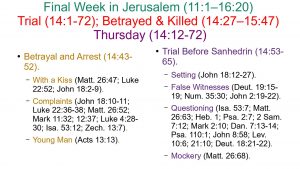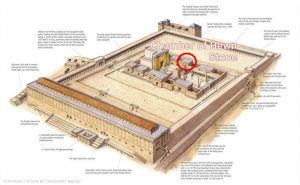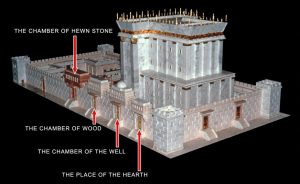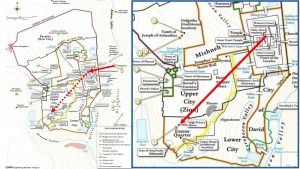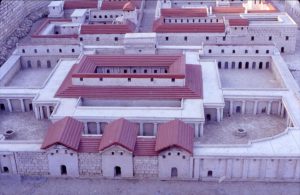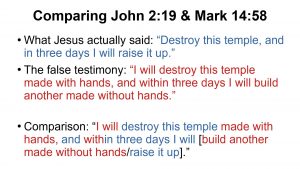Jesus’ Final Week in Jerusalem
Mark 11:1–16:20
Teaching (11:1–13:37)
King (11:1-11)
Sunday: Triumphal Entry (11:1-11).
Lawgiver (11:12–12:44)
Monday (11:12-19).
Tuesday (11:20–14:2).
Prophet (13:1-37)
Trial (14:1-72)
Sacrifice (14:1-26)
Wednesday (14:3-11).
Thursday (14:12-72)
The Passover (14:12-21).
The Last Supper (14:22-26).
Betrayed and Killed (14:27–15:47)
Peter’s Denial Prophesied (14:27-31).
Prayer in Gethsemane (14:32-42).
Betrayal and Arrest (14:43-52).
With a Kiss (14:43-46).
Complaints (14:47-50).
This is perhaps one of the most enigmatic passages in Mark, maybe even in all the Scripture.
Who is this young man, and why is he mentioned here and in no other gospel account? Seems like quite the non sequitur.
The only explanation that seems to have any merit is that this is Mark himself.
If so, then Mark is adding a bit of a personal touch to these events as an eye-witness, and just as John never mentions himself by name in his gospel account, Mark doesn’t mention who this is either.
This is the reason some suggest that the upper room where Jesus had His Last Supper was in Mark’s house.
After Mark had already gone to bed, he heard Jesus and His disciples leaving and decided to follow them.
He didn’t want to lose them, so he quickly threw a linen cloth around himself, following at a distance so no one knew he was there.
But he didn’t escape the notice of all those who came to apprehend Jesus, so he fled along with the Eleven.
He fled then, and he fled at the first sign of trouble on Paul’s first missionary journey (Acts 13:13).
Of course, that’s if this person is Mark. Sadly, we don’t know for sure.
 Trial Before Sanhedrin (14:53-65).
Trial Before Sanhedrin (14:53-65).Setting (14:53-54).
This so-called trial of Jesus was nothing more than a sham, a kangaroo court rigged against Him.
This is evident in all the rules they had broken in order to sentence Jesus to death—by some count there were 22 rules and laws broken.
Some of these rules are lifted straight from Scripture, but others came up over the years to help in issuing impartial and just judgments.
We won’t go into all of them, but it does show how desperate these leaders were in convicting Jesus by any means necessary.
 One of those rules was where the trial was conducted—it was to be held in a public place on the north wall adjacent to the temple called the Chamber of Hewn Stone.
One of those rules was where the trial was conducted—it was to be held in a public place on the north wall adjacent to the temple called the Chamber of Hewn Stone.But instead, it is held across town in the private home of Caiaphas, the high priest.
John records that Jesus first went to Annas, who was very influential and was official the high priest in AD 6-15 (John 18:12-14, 19-23).
Since high priests were meant to serve until their death, many believed he was the legitimate high priest, but the position had become a political one appointed by Rome.
They did try to find someone acceptable to the Jews, but who was also friendly to Rome so they eventually land on Caiaphas from AD 18-37. He was Annas’ son-in-law.
 After Jesus is seen by Annas, Mark’s account picks up with the trial at Caiaphas’ house where “all the chief priests, the elders, and the scribes” were assembled (John 18:24).
After Jesus is seen by Annas, Mark’s account picks up with the trial at Caiaphas’ house where “all the chief priests, the elders, and the scribes” were assembled (John 18:24).John allows Peter into the courtyard of the high priest’s house, and he was warming himself by a fire (John 18:15-16).
This is early spring, when the days may be comfortable, but the nights can get chilly which explains the fire.
But it also reminds us that this was taking place at night—another violation of the rules of Jewish jurisprudence.
Trials were not to be held in secret or at night to be as fair and as impartial as possible. But these Jewish leaders had no interest in fairness or impartiality, did they?
 Mark records Peter’s denial of Jesus after the trial, juxtaposing Jesus’ resolve and Peter’s cowardice.
Mark records Peter’s denial of Jesus after the trial, juxtaposing Jesus’ resolve and Peter’s cowardice.However, they took place at the same time as the trial as John records (John 18:12-27), but it makes sense for Mark to separate them out as historians often do, separating events that happened at the same time into their own narrative.
False witnesses (14:55-59).
Speaking of narrative, the Jewish leaders were trying to construct one of their own, a false narrative put together by false witnesses.
Of course, the OT Law required that no one be put to death unless it was on the testimony of two or three witnesses (Deut. 19:15-19; Num. 35:30).
Amazingly, after all the trial laws broken, sentencing Jesus to death at the testimony of just one witness was a bridge too far. They had enough integrity to see that—though that’s damning with faint praise.
And witness after witness was called, though none agreed.
Apparently some did make similar testimonies (14:58), but they must have been cross-examined in some way and found to disagree in certain key details not mentioned here.
 Nothing like this testimony is recorded in Mark, neither in Matthew or Luke. But there is something similar recorded in John 2:19, about three years previously when Jesus first overturned the tables of the moneychangers.
Nothing like this testimony is recorded in Mark, neither in Matthew or Luke. But there is something similar recorded in John 2:19, about three years previously when Jesus first overturned the tables of the moneychangers.Compare the actual statement with the false witness statement.
Eyewitness accounts are notorious for not being 100%, but this is why you need several witnesses to come forward and you need agreement on certain key details.
These so-called witnesses could not agree on those key details, and as we see, do not agree with what John records, either.
The false witnesses are making it seem like Jesus said He would destroy the brick and mortar temple and raise up another, perhaps one that is a spiritual in nature.
Perhaps that is what the people assumed, but that is not what Jesus meant, as John continues to write (John 2:20-22).
So Jesus was talking about Himself, not about the brick and mortar temple, something that was about to be fulfilled.
Questioning (14:60-64).
Another rule that was broken was that the defense had a chance to speak before witnesses were called by the prosecution.
Another rule stated that the accused had to have someone defending him and could not be compelled to testify against himself.
Only now is Jesus given a chance to speak, without a defender, and only to incriminate Himself.
He shrewdly keeps silent here. In our Constitution, we have the Fifth Amendment, where one cannot be compelled to testify against oneself. We are reminded of this upon arrest with our Miranda rights: “You have the right to remain silent ….”
But Jesus had a greater reason for keeping silent. Instead of simply keeping from incriminating Himself, He was doing as it was prophesied of Him: “He was oppressed and afflicted, yet He opened not His mouth; He was led as a lamb to the slaughter, and as a sheep before its shearers is silent, so He opened not His mouth” (Isa. 53:7).
Even so, Caiaphas pressed on, and as Matthew records, put Him under oath so that He was compelled to respond (Matt. 26:63).
He asked Him if He were “the Christ, the Son of the Blessed.”
Caiaphas seems to think that these two ideas are synonymous, that for one to be the Messiah, He must also be the Son of God.
This does connect a lot of things that we spoke about when covering Hebrews 1, that the Messiah prophesied in Psalm 2 (vs. 7) and 2 Sam. 7 (vs. 12) was to be the Son of God.
Jesus had made such claims previously and Caiaphas was eager to have Jesus admit to them under oath.
Jesus outright admits that it is true. He goes on to use so many more words, phrases, and symbols that are indicative of the Lord Himself.
Son of Man coming with the clouds of heaven. Jesus had already called Himself the Son of Man as far back as Mark 2:10 when He healed the paralytic. This is a reference to Daniel 7:13-14, where He will come in the clouds of heaven to the Ancient of Days (that is God the Father). If Jesus were being coy about the “Son of Man” reference before, now there can be no doubt what Jesus was referencing.
He will be sitting at the right hand of the Power, that is the Almighty. This is a reference to Psalm 110:1, “The Lord (YHWH) said to my Lord, ‘Sit at My right hand till I make Your enemies Your footstool.’”
I AM. While the NKJV does not give us the indication that this is a reference to Jesus being the I AM, the same Greek words are used here as are used in John 8:58, “Before Abraham was, I AM.” This may be a sly way the Lord is identifying Himself without coming out and saying it.
The high priest react by tearing his clothes, something which was forbidden for two reasons.
The high priest was not supposed to tear his clothes at all, not even for the death of a son (Lev. 10:6; 21:10).
Even so, tearing one’s clothes was an indication of one’s strong emotion, and such judgments were not meant to be based on emotion but on the testimony of the witnesses.
Of course, in this case, there was a lack of reputable witnesses, one could not be convicted based solely on their own testimony… and yet here we are.
He called it blasphemy, and yet that doesn’t make sense, does it?
Surely if a man were to claim to be the Christ and not actually be Him, then he could be guilty of blasphemy.
But the thing is, weren’t they expecting someone to come to be their Messiah?
Wouldn’t they want to test Him to see if this claim were true instead of dismissing it outright? (Deut. 18:21-22).
But they had no interest in that because Jesus was upsetting the apple cart and wouldn’t even entertain the possibility.
So they convict Him unfairly and unjustly, breaking another rule that a verdict could not be announced at night. The Just One suffers injustice.
Mockery (14:65).
And now they broke one more rule, that one condemned to death could not be beaten or scourged before the execution.
They mock Him by spitting on Him, blindfolding Him, and beating Him.
Matthew records that those mocking Him demanded that He prophecy who hit Him (Matt. 26:68).
They weren’t just mocking Jesus, but they were also mocking the Scripture that told them that prophesying was a way to determine if the individual were a prophet or even the Prophet (Deut. 18:21-22).
Apparently this was a children’s game, where they would blindfold someone, hit him, and ask that he say who did it.
This adds to the mockery, that they were making our Lord an unwilling participant in a much more violent version of a children’s game, using this as a vehicle to humiliate and beat Him.
All the while, Peter was denying Him.
